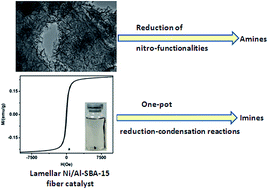Lamellar Ni/Al-SBA-15 fibers: preparation, characterization, and applications as highly efficient catalysts for amine and imine syntheses
Abstract
A novel Ni/Al-SBA-15 fiber catalyst with a lamellar structure was prepared by the urea precipitation method and successfully utilized in the environmental-friendly reduction of nitro functionality. The applications of the catalyst in highly efficient one-pot amine and imine syntheses were developed; the physicochemical properties of the samples were evaluated with ICP-OES, N2 adsorption, XRD, HRTEM, and EDX. This new catalyst highlights potent catalytic activities and a simple recycling process as an important environmentally-friendly feature.


 Please wait while we load your content...
Please wait while we load your content...